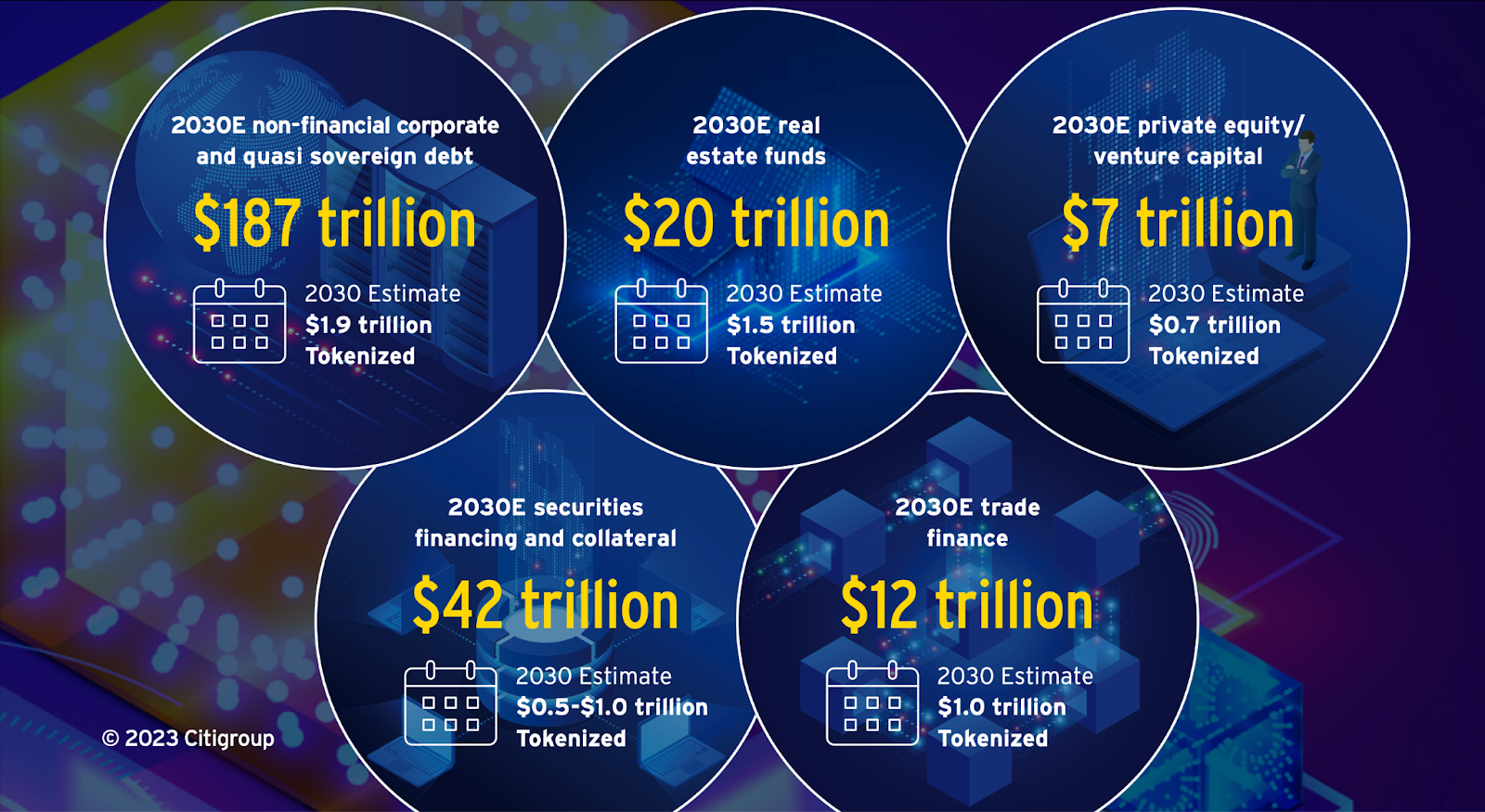
Real World Assets (RWA) are currently among the fastest-growing ecosystems within the larger Decentralized Finance (DeFi) market.
According to DeFi Llama metrics, there is over $4 billion in digital asset funds locked across RWA protocols such as Ondo Finance, Pendle and the Jellyverse ecosystem. This figure is up from $753 million in January 2023.
But while the RWA ecosystem has witnessed remarkable growth over the past year, it is still one of the most underserved DeFi markets.
A recent report by Citi estimates that the total addressable RWA market is in the trillions of dollars, with notable investment areas such as non-financial corporate debt, real estate, private equity, and securities set to contribute a significant chunk of RWA portfolios by 2030.

Source: Citi
It is also worth mentioning that RWAs have been around for quite a while in the form of stablecoins such as USDT and USDC, which are essentially a tokenized form of the U.S. dollar.
More recently, we’ve also seen traditional fund managers like Franklin Templeton and Blackrock take a huge interest in other types of RWAs. Both companies are already offering access to tokenized U.S. treasuries, with the former enjoying a market cap of $352 million, while Blackrock’s RWA portfolio is at $427 million as of this writing.
The Challenge in RWA Scaling and Adoption
Similar to other innovations in the DeFi sector, RWAs are yet to reach their potential due to fundamental, technical and regulatory challenges. This section will highlight some of the main reasons why RWAs remain underserved despite their value proposition.
Regulatory Clarity
Compliance is one of the main hurdles innovators and investors in the RWA market are currently experiencing. For example, in the U.S., the SEC has strict guidelines on what should be classified as a security.
The tokenization of real world assets such as real estate or art may deem them securities, which means that the stakeholders involved in the issuance and distribution might have to comply with security laws. This is just for one jurisdiction; other countries also have their own set of rules, which make the scaling of RWAs more complex.
Fragmented Technical Infrastructures
At the core, most RWA innovations are built using smart contract technology. While this type of infrastructure has its own perks, including automation and verifiability, it also has some shortcomings. Most notably, the RWA market is still fragmented given that innovators are choosing to build on different DeFi platforms such as Ethereum, Solana, and Parallel EVM chains such as Sei and Sui, which are designed to increase throughput by processing multiple transactions simultaneously.
Real-Time Valuation and Pricing
For RWAs to be effective, they need to accurately follow the price development of the real world assets being tracked at any point in time. While this can be achieved with assets such as stocks or commodities like gold which have real-time data sites with API integration, it is much harder for unique assets like art where the valuation can be highly subjective and influenced by factors like the artist’s reputation, market trends, and historical significance.
Market Liquidity
Up until recently when Blackrock announced its BUIDL U.S. Treasuries tokenized fund, most of the activity in the RWA market was concentrated around stablecoins. Of course, we cannot ignore the impact that Blackrock’s debut has had, but at the same time, one cannot help but notice that the RWA market is a drop in the ocean compared to more established traditional markets. For context, RWAs have a market cap of $8 billion as of press time, merely a fraction of the $9 trillion in AUM controlled by Blackrock alone.
Slow But Sure: RWAs Are the Future of Global Markets
Although the challenges listed above may take a while to solve, it is no secret that RWAs have the potential to shape the next era of globalized market ecosystems.
We’re already witnessing notable developments in this industry, with DeFi projects such as Jellyverse getting the greenlight from Liechtenstein’s Financial Market Authority for its DeFi utility token dubbed ‘jAssets’.
These tokens will track a diverse portfolio of traditional asset price feeds, giving investors a synthetic exposure to a wider range of traditional assets through their newly launched DeFi 3.0 platform. Some of the real world assets that ‘jAssets’ utility tokens will follow include ETFs, bonds, stocks, and commodities, among others.
It is also intriguing to observe that RWAs are expanding DeFi’s reach as more and more institutions take note or directly invest in research and development. Initially, the DeFi market was more of a degen hub with small-time crypto natives and whales running the show. This is no longer the case; even the likes of Larry Fink, Blackrock’s CEO, now acknowledge that RWAs may have a significant role to play in the future of finance,
“I believe the next generation for markets, the next generation for securities, will be tokenization of securities.” – Larry Fink.
More importantly, there is a lot of room for growth to support the innovation by crypto natives and institutions looking to deploy some money in tokenizing their holdings. To put this into perspective, the TVL in DeFi stands at $105 billion, with only $4 billion currently allocated towards RWAs; the rest is distributed between earlier DeFi and NFT innovations.
Meanwhile, on the global market front, traditional financial institutions, including the likes of JP Morgan and consulting firms such as BCG and McKinsey, all agree that there is a huge gap to be filled in the RWA market.
